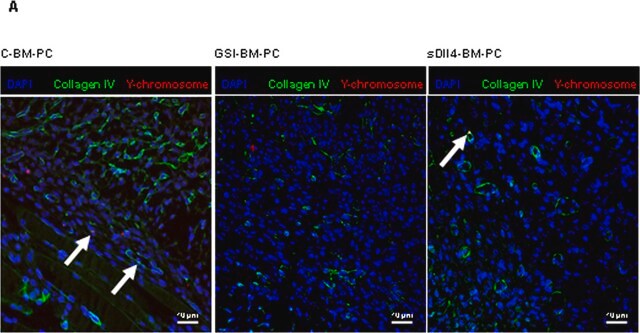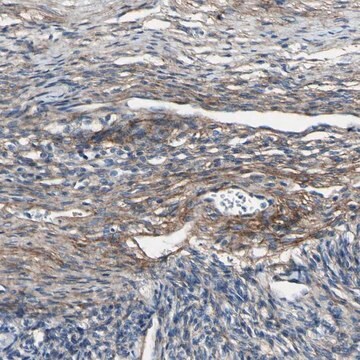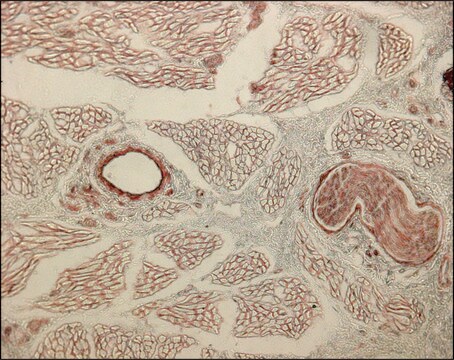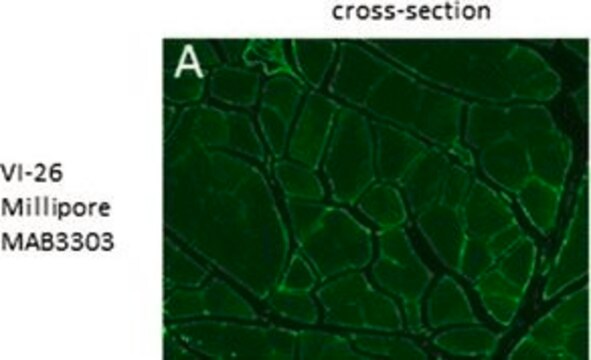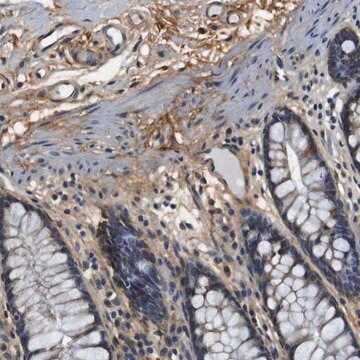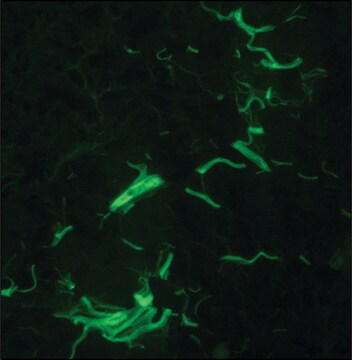MAB1944
Anti-Collagen Type VI Antibody, clone 3C4
ascites fluid, clone 3C4, Chemicon®
Synonym(e):
Collagen alpha-3(VI) chain, Collagen VI alpha-3 polypeptide
About This Item
Empfohlene Produkte
Biologische Quelle
mouse
Qualitätsniveau
Antikörperform
ascites fluid
Antikörper-Produkttyp
primary antibodies
Klon
3C4, monoclonal
Speziesreaktivität
human
Hersteller/Markenname
Chemicon®
Methode(n)
electron microscopy: suitable
flow cytometry: suitable
immunocytochemistry: suitable
immunohistochemistry: suitable (paraffin)
immunoprecipitation (IP): suitable
Isotyp
IgG1κ
NCBI-Hinterlegungsnummer
UniProt-Hinterlegungsnummer
Versandbedingung
dry ice
Posttranslationale Modifikation Target
unmodified
Angaben zum Gen
human ... COL6A3(1293)
Allgemeine Beschreibung
Spezifität
Immunogen
Anwendung
Zellstruktur
ECM-Proteine
Immunocytochemistry Analysis: Representative lots detected extracellular type VI collagen immunoreactivity in cultured fibroblasts isolated from Ullrich congenital muscular dystrophy (UCMD) and Bethlem myopathy (BM) patients by fluorescent immunocytochemistry (Kim, J., et al. (2012). Neuromuscul. Disord. 22(2):139-148; Allamand, V., et al. (2011). Skelet Muscle. 1:30; Briñas, L., et al. (2010). Ann. Neurol. 68(4):511-520; Jimenez-Mallebrera, C., et al. (2006). Neuromuscul. Disord. 16(9-10):571-582; Tétreault, M., et al. (2004). Brain. 129(Pt 8):2077-2084; Zhang, R.Z., et al. (2002). J. Biol. Chem. 277(46):43557-43564).
Immunocytochemistry Analysis: A representative lot detected exogenously expressed wild-type α3(VI) chain, as well as α3(VI) chain with G49A or G301V mutation in SaOS-2 transfectants by fluorescent immunocytochemistry (Lamandé, S.R., et al. (2002). J. Biol. Chem. 277(3):1949-1956).
Immunocytochemistry Analysis: Representative lots immunostained extracellular type VI collagen fibrils in human MG63 osteosarcoma cells and primary foreskin fibroblasts cultures (Bruns, R.R., et al. (1986). J. Cell Biol. 103(2):393-404; Engvall, E., et al. (1986). J. Cell Biol. 102(3):703-710).
Immunohistochemistry Analysis: A representative lot detected human type VI collagen immunoreactivity in frozen muscle tissue sections from mice grafted with human synovial stem cells (hSSCs) by fluorescent immunohistochemistry (Meng, J., et al. (2010). Neuromuscul. Disord. 20(1):6-15).
Immunohistochemistry Analysis: Representative lots detected type VI collagen immunoreactivity in muscle and skin samples from congenital muscular dystrophy (CMD) and Ullrich congenital muscular dystrophy (UCMD) patients by fluorescent immunohistochemistry using frozen tissue sections (Peat, R.A., et al. (2008). Neurology. 71(5):312-321; Jimenez-Mallebrera, C., et al. (2006). Neuromuscul. Disord. 16(9-10):571-582).
Immunoprecipitation Analysis: A representative lot co-immunoprecipitated type VI collagen α1(VI) and α2(VI) chains with wild-type α3(VI) chain, as well as α3(VI) chain with G16S or G49A mutation. Impaired α1(VI) and α2(VI) co-IP was observed with α3(VI) G301V mutant (Lamandé, S.R., et al. (2002). J. Biol. Chem. 277(3):1949-1956).
Immunoprecipitation Analysis: A representative lot immunoprecipitated type VI collagen alpha chains from Triton X-100 extracts of MRC-5 human lung fibroblasts (Engvall, E., et al. (1986). J. Cell Biol. 102(3):703-710).
Electron Microscopy Analysis: A representative lot detected reduced extracellular type VI collagen immunoreactivity in cultured fibroblasts isolated from an Ullrich congenital muscular dystrophy (UCMD) patient (Zhang, R.Z., et al. (2002). J. Biol. Chem. 277(46):43557-43564).
Electron Microscopy Analysis: A representative lot immunostained extracellular filaments and fibrils by binding to the band (non-helical) region of the type VI collagen fibrils using cultured human foreskin fibroblasts (Bruns, R.R., et al. (1986). J. Cell Biol. 103(2):393-404).
Dot Blot Analysis: A representative lot detected exogenously expressed wild-type α3(VI) chain, as well as α3(VI) chain with G49A or G301V mutation in the medium of cultured SaOS-2 transfectants (Lamandé, S.R., et al. (2002). J. Biol. Chem. 277(3):1949-1956).
Zielbeschreibung
Physikalische Form
Lagerung und Haltbarkeit
Rechtliche Hinweise
Haftungsausschluss
Sie haben nicht das passende Produkt gefunden?
Probieren Sie unser Produkt-Auswahlhilfe. aus.
Lagerklassenschlüssel
10 - Combustible liquids
WGK
WGK 1
Flammpunkt (°F)
Not applicable
Flammpunkt (°C)
Not applicable
Analysenzertifikate (COA)
Suchen Sie nach Analysenzertifikate (COA), indem Sie die Lot-/Chargennummer des Produkts eingeben. Lot- und Chargennummern sind auf dem Produktetikett hinter den Wörtern ‘Lot’ oder ‘Batch’ (Lot oder Charge) zu finden.
Besitzen Sie dieses Produkt bereits?
In der Dokumentenbibliothek finden Sie die Dokumentation zu den Produkten, die Sie kürzlich erworben haben.
Unser Team von Wissenschaftlern verfügt über Erfahrung in allen Forschungsbereichen einschließlich Life Science, Materialwissenschaften, chemischer Synthese, Chromatographie, Analytik und vielen mehr..
Setzen Sie sich mit dem technischen Dienst in Verbindung.
